The Smart Growth Manual: a Review

Posted January 4, 2010 at 1:38PM
Before getting to disclaimers and qualifications, let me say at the outset that I like this new book a lot. Written by new urbanist uberforce Andres Duany and his firm’s alumnus Jeff Speck with Mike Lydon, founder of the Street Plans Collective, The Smart Growth Manual (McGraw-Hill, 2009) comprises a concise and affordably priced (list, $24.95) compendium of well-illustrated policy, planning and architectural principles in fewer than 200 pages. It is complex and simple at the same time and, if its tenets were followed by community planners and builders everywhere, we would have a better and more sustainable world. Reviewing a book with such lofty intentions seems a great way to kick off this blog’s new year.
Now the disclaimer: I know Andres and Jeff personally and respect their work tremendously. I served for several years as a volunteer task force chair at the Congress for the New Urbanism, which Andres co-founded, and learned a lot. I haven’t always agreed with Andres or other new urbanist leaders on growth management policy or on how some of their designs have been manifested in the real world; but our personal relationship has always been great. My own work is better for having known Andres, his associates, and their work.
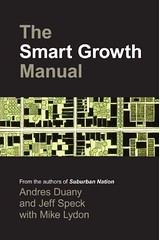 With that out of the way, I will begin for real by saying that, if you’re going to write something called “the smart growth manual,” purporting to be definitive, it had better be good. All the more so if you’re in the world of development and profiting handsomely from it, have a reputation for pursuing greenfield development, and have rather visibly slammed the environmental movement on more than the odd occasion. It’s probably not by accident that, in saluting the “intellectual leadership” that is attempting to steer American development toward a more sustainable course, the authors cite the American Planning Association, the Urban Land Institute, CNU (i.e., themselves) and government agencies, but not the environmental community or the smart growth movement.
With that out of the way, I will begin for real by saying that, if you’re going to write something called “the smart growth manual,” purporting to be definitive, it had better be good. All the more so if you’re in the world of development and profiting handsomely from it, have a reputation for pursuing greenfield development, and have rather visibly slammed the environmental movement on more than the odd occasion. It’s probably not by accident that, in saluting the “intellectual leadership” that is attempting to steer American development toward a more sustainable course, the authors cite the American Planning Association, the Urban Land Institute, CNU (i.e., themselves) and government agencies, but not the environmental community or the smart growth movement.
So, um, Dick Moe, Ralph Grossi, Don Chen, Bruce Katz, Constance Beaumont, Scott Bernstein, Stockton Williams, Michael Replogle, Angela Glover Blackwell and several others among my fellow non-intellectuals (or is it non-leaders?) would like to say hi. We do get a passing mention in the book’s opening pages, in the context of suggesting that “specialized concerns” have led us to omit important issues from our thinking, and that it is the authors who can give the reader “a more complete, less politicized” set of principles defining smart growth than can the smart growth movement itself. The “issues are too important to be left” to those outside the building industry, they write. (Humility has never been the strong suit of new urbanism; but I must admit that it has not exactly been a strong suit of the environmental community, either.)
But, you know what? This is a really, really good book. I started out by expecting to be able to applaud 75-80 percent of its substance and 90 percent of its style, but in the actual reading I enthusiastically applaud 95 percent of its substance and 100 percent of its style. Well done, guys.
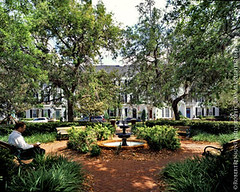 The book starts from the overarching principle that “new places should be designed in the manner of existing places that work.” That’s Traditional Neighborhood Design in a nutshell and, though I think allowances need to be made for innovation and creativity, it’s not a bad starting point to take past success as a measure and to weigh new concepts against the best of the old.
The book starts from the overarching principle that “new places should be designed in the manner of existing places that work.” That’s Traditional Neighborhood Design in a nutshell and, though I think allowances need to be made for innovation and creativity, it’s not a bad starting point to take past success as a measure and to weigh new concepts against the best of the old.
The book is structured to take the reader from big-picture considerations to smaller ones, more specifically from matters pertaining to metropolitan regions to those pertaining to, in turn, neighborhoods, streets, and buildings. One of the book’s strengths but also one of its limitations is that these correspond well to the on-the-ground patterns of our built environment, which unfortunately means they also correspond hardly at all to how policy and marketplace decisions – the things the authors want to influence – get made. The authors are absolutely correct that America’s almost random patchwork of municipal governance gets in the way of smart growth, badly, but the paradox is that some of the book’s contemplated solutions will be hard to implement because of it. Maybe that’s why new urbanists seem so fond of championing large, planned “new towns” in what was previously the countryside: it gives them a scale, usually within the control of a single regulating authority and single owner, at which they can implement nearly the full range of their ideas with the least aggravation. (New urbanists don’t get nearly enough credit for the large amount of revitalization, urban infill, historic preservation, and conservation planning that they also do, by the way.)
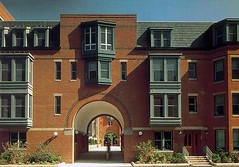 Perhaps the book’s strongest asset is its stylistic clarity. Under the four broad categories noted above, there are sub-categories and numbered principles. Each principle is stated in a simple imperative sentence, e.g., “Keep blocks small, especially downtown.” Each principle then gets a single page, with explanatory narrative and a single visual illustration. This leaves the reader to do some filling in, but it also makes the book immensely readable and scannable. As the authors state forthrightly, they are aware that few books actually get read, and they would rather be criticized for brevity than avoided for length. Good for them, and us. Concepts that are more complex may get four or five separate, interlocking principles (as does public transit, for example), but each is discretely stated and illustrated. The book’s only stylistic shortcoming is a maddening lack of page numbers (presumably to force the reader to focus on the numbers of the principles; but why not both?).
Perhaps the book’s strongest asset is its stylistic clarity. Under the four broad categories noted above, there are sub-categories and numbered principles. Each principle is stated in a simple imperative sentence, e.g., “Keep blocks small, especially downtown.” Each principle then gets a single page, with explanatory narrative and a single visual illustration. This leaves the reader to do some filling in, but it also makes the book immensely readable and scannable. As the authors state forthrightly, they are aware that few books actually get read, and they would rather be criticized for brevity than avoided for length. Good for them, and us. Concepts that are more complex may get four or five separate, interlocking principles (as does public transit, for example), but each is discretely stated and illustrated. The book’s only stylistic shortcoming is a maddening lack of page numbers (presumably to force the reader to focus on the numbers of the principles; but why not both?).
The region is probably the scale at which smart growth advocates and new urbanists sometimes tend to disagree; smart growth advocates seek compact regional footprints and are suspicious of the new urbanist transect that (grossly oversimplified) seems to sanction some form of new development just about anywhere on private land. We tend to be more prescriptive at the regional scale and more permissive at the neighborhood scale, compared to new urbanists, who are just the opposite.
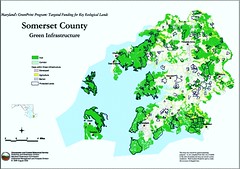 But I really like The Smart Growth Manual’s approach to regional thinking and planning. On the development side, the authors clearly prioritize revitalization and infill, recommend that every area accommodate subsidized affordable housing (we could have used that voice in the LEED-ND deliberations, where an affordable housing prerequisite was defeated), stress preserving the “agricultural hinterland” (likewise), advocate cross-municipality revenue sharing, promote curtailing growth in places where water is scarce, and are clear-eyed about the siting of important but locally unwanted land uses such as stadiums and waste facilities. (I partially disagree with the manual’s take on “shrinking cities,” and also wish it came out strongly for growth boundaries but, so what? I wouldn’t expect 100 percent agreement. We don't always agree on policy details within the smart growth world, either.)
But I really like The Smart Growth Manual’s approach to regional thinking and planning. On the development side, the authors clearly prioritize revitalization and infill, recommend that every area accommodate subsidized affordable housing (we could have used that voice in the LEED-ND deliberations, where an affordable housing prerequisite was defeated), stress preserving the “agricultural hinterland” (likewise), advocate cross-municipality revenue sharing, promote curtailing growth in places where water is scarce, and are clear-eyed about the siting of important but locally unwanted land uses such as stadiums and waste facilities. (I partially disagree with the manual’s take on “shrinking cities,” and also wish it came out strongly for growth boundaries but, so what? I wouldn’t expect 100 percent agreement. We don't always agree on policy details within the smart growth world, either.)
The recommended process for regional planning that begins with greenprinting and mapping of a region’s rural reserve, then designates areas both for consolidation of preserved rural land and for high-priority development is exactly how it should be done. The transportation chapter is abundantly clear and could have been written without much change by NRDC and our colleagues in the Transportation for America and Complete Streets coalitions. (Again, I have some minor quibbles in that, for example, the book advocates congestion pricing of roadways without qualification, but I disagree not at all on the goals.)
The book is strongest in its treatment of the neighborhood and street scales, as one might expect given the authors’ experience. Many people in the smart growth community neglect the neighborhood scale, and in my opinion that is a huge mistake. 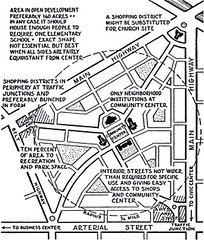 If we don’t get the neighborhoods right, our hopes for more compact regions and more efficient transportation patterns will never be accepted. Also, we can actually get things done at the neighborhood scale while engaging in seemingly endless arguments about larger-scale policy.
If we don’t get the neighborhoods right, our hopes for more compact regions and more efficient transportation patterns will never be accepted. Also, we can actually get things done at the neighborhood scale while engaging in seemingly endless arguments about larger-scale policy.
Here, somewhat to my surprise, the book starts out by stressing respect for neighborhood-scale nature (“retain and protect major natural features”; “design public places around existing trees”; “protect wetlands with upland buffers”). I could have used more content with respect to green stormwater infrastructure, but the subject comes up again in the street section, and there is a reference to Thomas Low’s excellent Light Imprint Handbook, which treats the subject thoroughly. (Andres was kind enough to give me a copy some time back. Low heads the Charlotte office of Duany Plater-Zyberk.)
The basic elements of smart neighborhood design are then given their due. These include mixed uses, housing diversity, jobs-housing balance, neighborhood schools, pocket parks, transit orientation, neighborhood organization, and more. Walkability is usually the key and, while these are familiar subjects to most of us, the Manual’s consistent, concise structure is what sets it apart and makes it especially useful. (Here, my respectful substantive dissent is on conservation subdivisions, which the book cites with approval and which I think can exacerbate sprawl.)
 If I gave as much space to commenting on the book’s treatment of streets and individual buildings as I have on the regional and neighborhood elements, this would get way too long and you would stop reading (recall the authors' comment on brevity versus length). I note, however, that my friend Barbara McCann of the Complete Streets Coalition will be pleased that complete streets get their own numbered principle, as do context-sensitive streets. The street section also has two more points about stormwater control with pervious surfaces, which will please NRDC’s water guru Nancy Stoner. Some surprises in these sections may be admonitions to be careful about skyscrapers and pedestrian malls (well argued, and I agree on both counts). There is quite a bit on parking and green buildings (both good); I wish there were more on historic preservation, which gets a mention only in the context of building codes that are so demanding that they inhibit historic rehabs.
If I gave as much space to commenting on the book’s treatment of streets and individual buildings as I have on the regional and neighborhood elements, this would get way too long and you would stop reading (recall the authors' comment on brevity versus length). I note, however, that my friend Barbara McCann of the Complete Streets Coalition will be pleased that complete streets get their own numbered principle, as do context-sensitive streets. The street section also has two more points about stormwater control with pervious surfaces, which will please NRDC’s water guru Nancy Stoner. Some surprises in these sections may be admonitions to be careful about skyscrapers and pedestrian malls (well argued, and I agree on both counts). There is quite a bit on parking and green buildings (both good); I wish there were more on historic preservation, which gets a mention only in the context of building codes that are so demanding that they inhibit historic rehabs.
At the end, there is a directory of organizations that work on smart growth. I am pleased that NRDC got a mention; not so pleased that the authors got our name wrong (“National” instead of the correct “Natural” Resources Defense Council) but, sadly, everyone makes that mistake. For more, readers may want to take a look at Alec Appelbaum’s recent interview with Andres and Jeff in Metropolis Magazine, which is pretty interesting, especially with regard to the book’s structure and concept.
My own bottom-line verdict is that this little manual is an outstanding, (mostly) highly pragmatic summary of what we need to do and how we need to do it. Think of it as a well-supported and -illustrated checklist. My quibbles are few and minor, in the overall context, and I only wish NRDC had written something this good first. I definitely intend to purchase copies for my colleagues. The Smart Growth Manual may be the best book on these subjects that I have read since Peter Calthorpe’s The Next American Metropolis (1993), which is high praise from me: that book literally changed my life.